INTRODUCTION
Saliva is the mixture of fluids that originates from major and minor salivary glands and nonglandular sources such as crevicular fluids, oral microorganism, and host cells.1 Saliva is importance to maintain oral health, and saliva has multiple functions.2
Saliva have two functions that is digestive and protective functions and additional functions.3 Digestive functions include chewing of food, bolus formation, and swallowing. To the protective functions include self cleansing, lubricate the oral tissues by mucins,1 ability of the buffer to maintain salivary pH around 7.0, and antimicrobial action.3 Additional functions include articulate speech and excretion.3 Saliva is very influential on the dental health because of the chemical composition, the buffer capacity (buffer), antimicrobial activity, and salivary flow rate (flow rate).4
Salivary flow rate can be obtained with or without stimulus, that is the stimulated and the unstimulate salivary flow.5 Reduced salivary flow rate can be cause impedes the mastication and swallowing of food, neutralization of acids, and leads to oral diseases such mucosal lesions, caries, candidiasis, gingivitis, and periodontal diseases.6, 7
One effort that can be done to overcome the problem of reduced salivary flow is by stimulating saliva with citric acid and vitamin C in patients xerostomia.5, 8 Citric acid content is widely available in the pineapple and papaya with citric acid content of 346 mg pineapple and papaya is 335 mg.9 Pineapple and papaya also contains vitamin C with the 24 mg pineapple and papaya is 61.8 mg.10, 11 Lewapadang et al (2015) research stated that the consumption of pineapple juice in the elderly can reduce xerostomia and increase secretion saliva.12 Widya research (2013) that eating papaya can lower the debris index, and to chew papaya can stimulate to produce more saliva.13 The present study was aimed to determine the presence of differences in salivary flow before and after stimulation between chewing pineapple (Ananascomocus) and chew papaya (Carica papaya).
METHODS
Type of research is pre-experimental study with two group pretest posttest design. This research was conducted in the building of the Faculty of Dentistry Unsyiah. The sample in the present study were all students from Faculty of Dentistry, University of Syiah Kuala. Subjects who met the inclusion criteria obtained as many as 100 people.
Subjects were instructed not to eat, drink, chew, smoking, brush of teeth, and physical exercise for at least one hour prior to the saliva collection time.14 Saliva collection were obtained at 9-11 am, in a ventilated and well illuminated room.5 The first group was given 100 grams of pineapple that has been cut and the second group was given papaya 100 grams. Both groups were asked to chew pineapple and papaya for 2 minutes, then given time to rest for 5 minutes. Spitting saliva collection methods were conducted with a total of 5 minutes, with the way the subjects were instructed to remain silent for one minute, then every 1 minute subjects were asked to remove the accumulated saliva in the mouth and ejected into a measuring cup.15
RESULTS
Resultof difference in salivary flow rate before and after stimulation between chewing pineapple and chewing papaya on the students of the Faculty of Dentistry, University of Syiah Kuala generation from 2013 to 2016.
Data about salivary flow rate before and after chewing pineapple (Ananascomocus) and flow rate of saliva before and after chewing papaya (Carica papaya) tested the normality using the Shapiro-Wilk test. Normality test results demonstrate the significant value of salivary flow were obtained before and after chewing pineapple (Ananascomocus) and flow rate of saliva before and after chewing papaya (Carica papaya) p > 0.05, which indicates that the normal distribution of data.
DISCUSSION
This study was conducted to see the effect of chewing pineapple (Ananascomocus) and papaya (Carica papaya) against salivary flow.
Table 1.2 shows the differences in salivary flow before and after stimulation of chewing pineapple (Ananascomocus). This is related to a chemical stimulus in the form of citric acid that is found in pineapple, where the acid is the most powerful stimulus in increasing the secretion saliva16 and to chewing pineapple as a mekanis stimulus.2 This is in accordance with Lewapadang W et al (2015) stated that the citric acid content pineapple fruit can stimulate the salivary glands are parotid, submandibular, sublingual, and minor glands.12
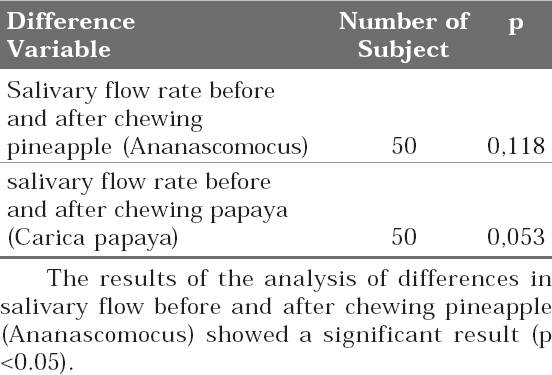
|
Table 1.1: Normality test of salivary flow rate
Click here to view |
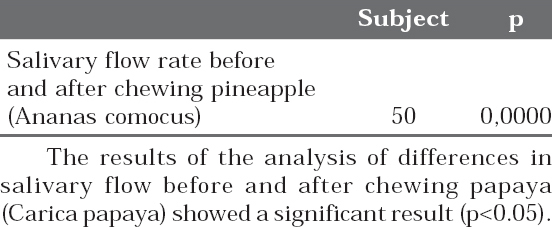
|
Table 1.2: Results of difference salivary flow rate before and after chewing pineapple
Click here to view |
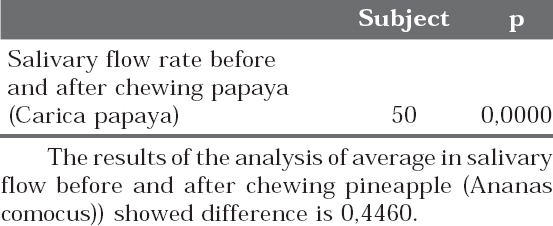
|
Table 1.3: Results of difference salivary flow rate before and after chewing papaya
Click here to view |
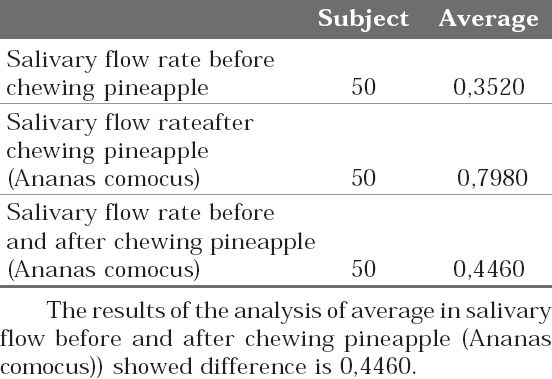
|
Table 1.4: Results of average salivary flow rate before and after chewing pineapple
Click here to view |
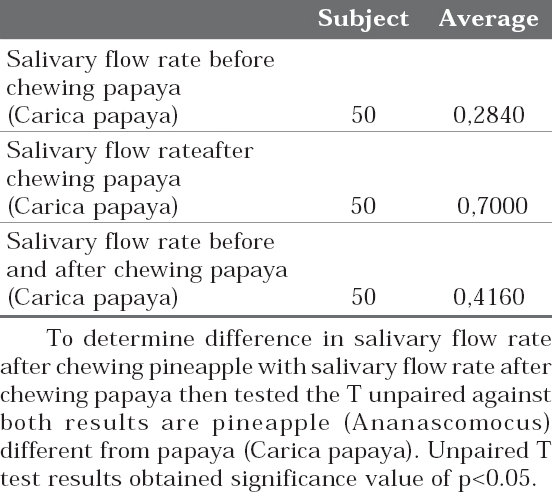
|
Table 1.5: Results of average salivary flow rate before and after chewing papaya
Click here to view |

|
Table 1.6: Result of difference salivary flow rate after chewing pineapple and papaya
Click here to view |
RESULT OF DATA EXAMINATION
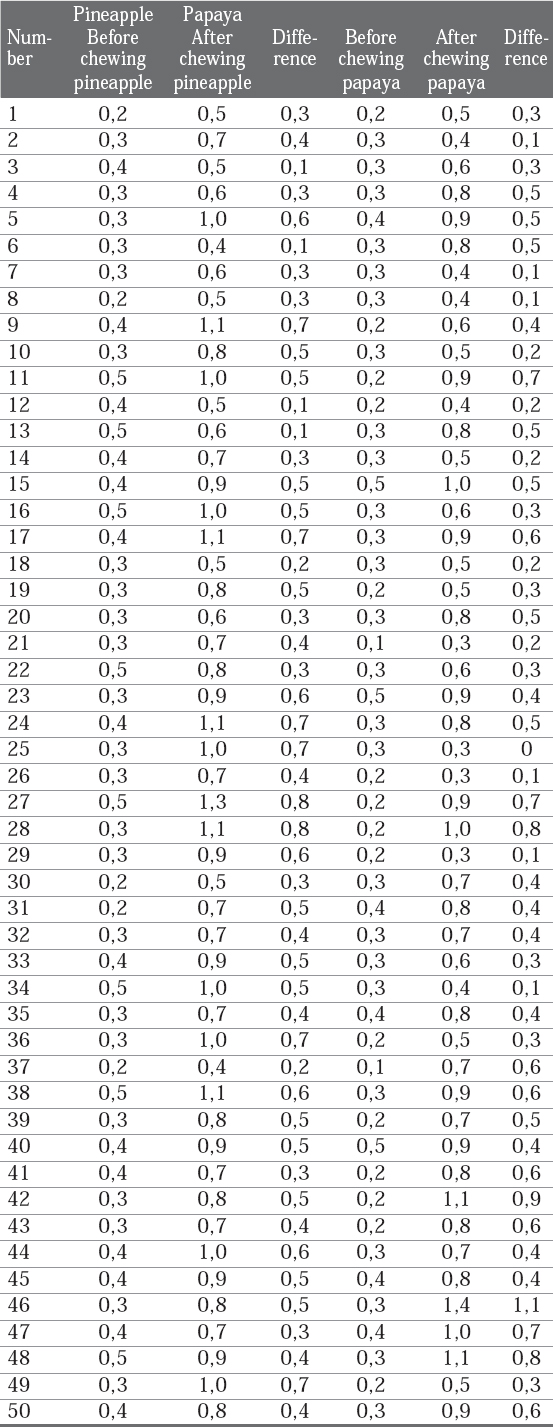
|
Click here to view |
Table 1.2. shows that there are differences in salivary flow before and after stimulation of chewing papaya (Carica papaya). This is related to a chemical stimulus in the form of citric acid and vitamin C in papaya as well as chewing movements papaya.2, 5, 12 Visvanathan (2010) stated that vitamin C in pineapple and papaya can increase the saliva flow rate.8,10,11
This study shows there are differences in salivary flow rate after stimulation of chewing pineapple (Ananascomocus) and papaya (Carica papaya), with a flow rate of saliva after chewing pineapple (Ananascomocus) higher than after chewing papaya (Carica papaya). Ana (2010) states that the greater the concentration of citric acid causes the salivary volume increased to higher than citric acid in a concentration low.17 This is consistent with citric acid content is higher in the 346 mg in pineapple compared in papaya is 335 mg.9
CONCLUSIONS
-
There are differences in salivary flow before and after stimulation of chewing pineapple (Ananascomocus).
-
There are differences in salivary flow before and after stimulation chewing papaya (Carica papaya).
-
There are differences in salivary flow with stimulation of chewing pineapple (Ananascomocus) and papaya (Carica papaya), with chewing pineapple (Ananascomocus) can increase the salivary flow rate higher than chew papaya (Carica papaya).
